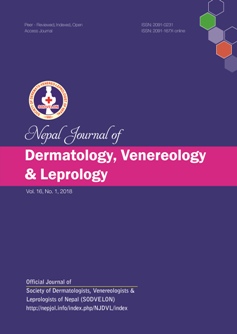Efficacy and safety of neem seed extract compared with clotrimazole in tinea corporis/ cruris: A randomized controlled trial
DOI:
https://doi.org/10.3126/njdvl.v16i1.19400Keywords:
Azadirachta, clotrimazole, ergosterol, potassium hydroxide, seed, tineaAbstract
Introduction: Tinea corporis and tinea cruris are common superficial fungal infections. Neem (Azadirachta indica) seed extract has shown antifungal properties in vitro, but no clinical studies have been done for superficial dermatophytoses. This study compared the efficacy and safety of 5% neem seed extract in cream base with 1% clotrimazole cream when used twice daily for four weeks, in the treatment of localized tinea corporis and/or tinea cruris.
Materials and Methods: This is a randomized, double blind, clinical trial. Patients with localized tinea corporis and/or tinea cruris were evaluated at baseline, week 1, week 2 and week 4. Clinical, mycological and effective cure rates of both treatment groups were determined. The patients’ post treatment overall satisfaction scores and the incidence of adverse effects were also documented.
Results: Sixty patients were recruited, and 30 patients were randomized to each treatment arm. There were no significant differences in post treatment scores (p value=0.221). Effective cure, defined as the combination of marked clinical improvement and mycological cure, was seen in 20/30 (66.67%) in the neem seed extract group and 24/30 (80%) in the clotrimazole group (relative risk = 1.67, 95% confidence interval = 0.69 – 4.0). Post treatment overall satisfaction scores were comparable (p value = 0.333). Two patients experienced adverse effects in the neem seed extract group, while there were no adverse effects in the clotrimazole group.
Conclusion: Efficacy and safety of 5% neem seed extract in cream base is comparable to 1% clotrimazole cream for the treatment of localized tinea corporis and/or tinea cruris.
Downloads
Downloads
Published
How to Cite
Issue
Section
License
Copyright on any research article is transferred in full to Nepal Journal of Dermatology, Venereology & Leprology upon publication. The copyright transfer includes the right to reproduce and distribute the article in any form of reproduction (printing, electronic media or any other form).




